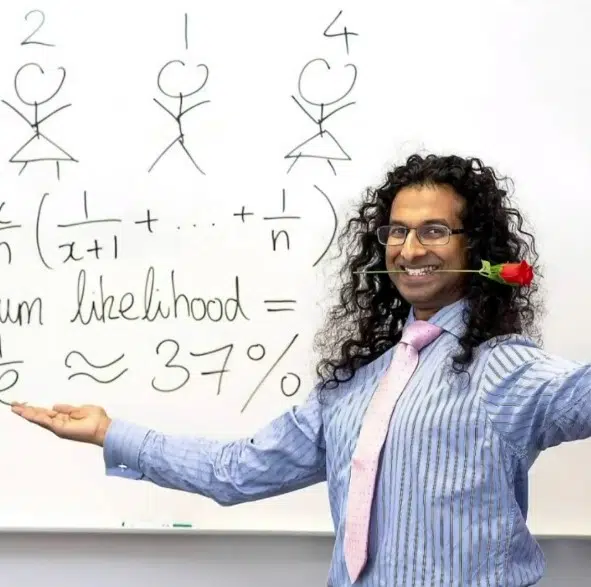
As couples gather on February 14 to celebrate Valentines Day, very few are likely to associate love with a mathematical equation. However, one mathematician believes that he has found the perfect equation for finding love.
Dr. Gihan Marasingha has devised a formula to help singles find a relationship. Specifically, Dr. Marasingha reckons the equation will work for singles searching with online dating apps.
Romantic relationships have been studied in a variety of contexts in different academic fields, including psychology, sociology, behavioural ecology, mathematics etc.
Could an equation help you find love?
Dr. Gihan Marasingha, who lectures at the University of Exeter, appeared on the British TV channel ITV to discuss his love equation.
According to the university, “His research focus is in analytic number theory, a subject intimately connected to the study of prime numbers. Much of his work has been directed at proving results concerning the density of almost-primes in sequences of numbers. He also investigates problems at the interface between analytic number theory and arithmetic geometry.”
According to the doctor, those looking for love should search within a pool of 100 potential partners. They should be able to find the ideal partner within 37 attempts. Presumably, the pool of 100 would be found on an online dating app.
“The probability that you’ll select the best date having seen the first X suitors is X divided by n (potential suitors) then multiplied by one divided by X plus one and so on,” Dr. Marasignha explained.
“You can try each one in turn but cannot return to one you have already tried,” he continued. “One strategy is to try a certain proportion of the suitors and then select the next suitor who ranks higher than all those so far seen.”
“The question arises, ‘What is the optimal proportion of suitors to test’? The answer is approximately 37 per cent.”
“Then it should be those straight after if you haven’t found it there.”
The rationale behind Dr. Marasingha’s love equation is that men are three times as likely to match or “swipe right” on dating apps as women, who are statistically more picky about choosing partners.
The science of love
Of course, Dr Marasingha’s love equation is not the first attempt to use science to simplify the often complicated realities of romance. Many studies and theories have been proposed to explain certain elements of love at an emotional level, or human sexual selection in the more biological sense.
For example, according to one study published in the journal Evolutionary Psychological Science, Women find men who have pictures posing with their dogs on their online dating profiles more attractive.
Researchers at St Mary’s University in Canada found that men who are looking for long-term partners are more likely to pose alongside a dog on their profiles.
Professor Maryanne Fisher, an evolutionary psychologist at the university who led the study, told The Times that men looking for a short-term fling were more likely to show off their “chests, their motorcycles, their boats, and the big fish they caught on the weekend.”
The study examined 750 dating profiles, including 225 men seeking a long-term relationship, 225 women who wanted the same, and 225 men looking for a casual fling.
See all the latest news from Greece and the world at Greekreporter.com. Contact our newsroom to report an update or send your story, photos and videos. Follow GR on Google News and subscribe here to our daily email!



